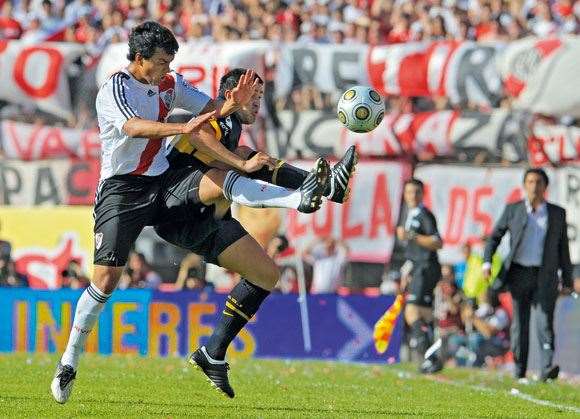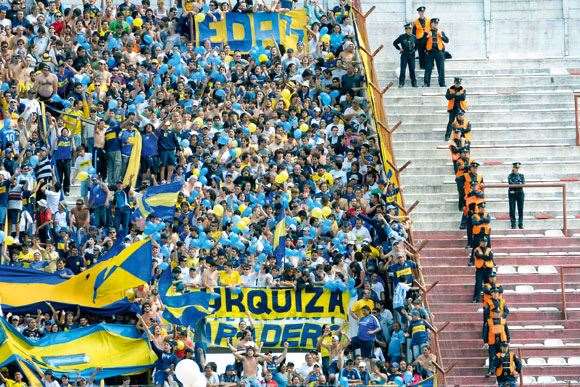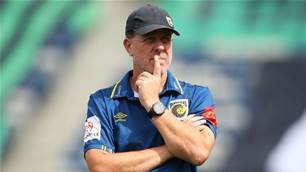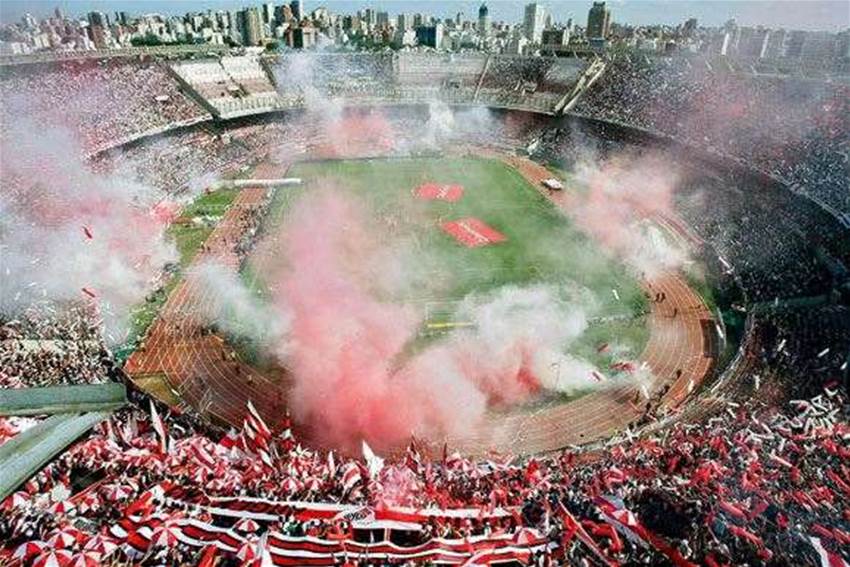The Buenos Aires cross-town between Boca Juniors and River Plate represents perhaps the world’s biggest soccer rivalry in the world’s most soccer-mad country. Inside Sport squeezed in for a look.
The Buenos Aires cross-town between Boca Juniors and River Plate represents perhaps the world’s biggest soccer rivalry in the world’s most soccer-mad country. Inside Sport squeezed in for a look.
 La Monumental explodes in a show of support for River Plate.
La Monumental explodes in a show of support for River Plate.Images: Getty Images
IT’S THREE HOURS till kick-off and already the suburb of Belgrano is in lockdown. Streets are blocked off with chain link gates and fences improvised from ragged slabs of wood. At every crossroad there’s a detachment of riot police kitted in black helmets, jackboots, body armour. Around them are swarms of dark-skinned men in security uniforms, their faces scrawled with tattoos that look alarmingly prison-drawn. There’s a River Plate street and, four blocks south, there’s a Boca street. This is about as close as the two armies will get.
On the River Plate front there’s a carnival air. A giant barbecue throws out a plume of smoke, the houses are draped in red and white flags, old stereos blast out River chants. A knot of red and white fans, bunched at the first of eight security checkpoints, breaks into song. It’s a strident, militant tune, but they sing at no great volume – they know they’re going to need their voices later on:
“Wherever you go we’ll always be there.
You’re my life, what I love most.
These are your fans, these are your people.
Those who love you, those who sing for you.
River Plate, River Plate, River Plate, River Plaaaate!”
Four blocks away a knot of blue and gold Boca fans is bunched at the first of its eight security checks. There’s no carnival on this side, no barbecue, no singing. The houses have their curtains drawn, their doors locked. The Boca fans push in tight and look about with short, conspiratorial glances. No one’s talking. Perhaps it’s the platoon of riot police standing in three rows, at attention, their batons drawn.
 Boca Juniors’ Juan Roman Riquelme and River Plate’s Gustavo Cabral at war.
Boca Juniors’ Juan Roman Riquelme and River Plate’s Gustavo Cabral at war.Images: Getty Images
I know what the atmosphere is like on both fronts because I get off the bus a stop too early and wander down the Boca streets. I vaguely wonder why two ratty youngsters with cigarettes clamped between their teeth are staring at me with hard eyes. I join the back of the throng at the checkpoint and look about breezily. A security guard sidles up. He silently takes me by the elbow and leads me towards the platoon of riot police. He examines my ticket. “You’re sitting at the River end,” he whispers into my ear. “You must leave here.” He unlocks a chain link gate and pushes me through.
As I negotiate the umpteen security checkpoints back to the River streets, I muse on a story I had heard. In the mid ‘90s a London journo was standing agog on the terraces during a Superclasico game as the flares and smoke bombs exploded and an unearthly din shuddered through the towering concrete stands. The journo asked the man standing next to him – a Falklands War veteran – if this was akin to warfare. The old vet shook his head. “No,” he said, “this is about love.” Boca lost 2-0 that day. After the game two River Plate fans were shot dead. Before night fell, graffiti began appearing around the city: “River 2-2 Boca.”
A recent survey found that 40 per cent of Argentineans call themselves Boca fans, 32 per cent River fans. With close to 30 million supporters between them, these two clubs are the colossi that loom over Argentinean football. And it’s difficult to overstate the enmity they feel for one another. It’s a hatred born of proximity – the heartlands of both clubs are separated by the few acres of BA’s Microcentro. It’s a hatred maintained by the closeness of the contest – of the 325 games played, Boca has won 119, River 102, with 104 games finishing in a draw. But above all, it’s the hatred of a class war.
La Boca is a grimy dockside barrio sprawling south of the city centre. It was thrown up in the 1870s when boatloads of Genoese workers flooded Buenos Aires. They arrived destitute, built ramshackle slums of wood and corrugated zinc, and ground out their days on the docks and in the shipyards. These days, the slums around La Boca’s port have been tarted-up in gaudy colours and tourists flock to the area to buy cheap paintings of tango dancers and marvel at the raffish squalor of old Buenos Aires. But you don’t have to walk too far beyond the tourist precinct to see the graffiti, the splintering slums, the cracked roads, the rake-thin children, and know that the squalor is still very real.
River Plate territory, by contrast, is north of the city centre. These suburbs – Recoleta, Palermo, Belgrano – also sprung up in the 1870s when the gentry noticed its servants were dropping dead of consumption. Terrified, they abandoned their San Telmo mansions and fled north, where the air was fresh and the river clean. They laid out grand tree-lined avenues and sprawling parks replete with polo grounds and hippodromes. These days the parks fill with joggers and paseo perros – young men paid to walk the dogs of the Porteno yuppies.
Sip a ristretto in a Recoleta cafe and you could be in Paris; knock back a longneck of Quilmes in a Boca bar and you’re definitely in South America. It’s a class war the two armies gladly indulge. River fans call themselves Los Millonaros – the Millionaires; Boca call themselves Los Xeneizes – the Genoese. Boca’s stadium, La Bombonera, is a sheer 50,000-seat fortress that rises straight from the grey docklands. Its concrete walls are covered in hellish murals showing shadowed workers grinding away on the dark satanic docks. River’s stadium, La Monumental, is a vast two-tiered concrete bowl surrounded by golf courses and banks of clay tennis courts. Its walls are emblazoned with Adidas logos.
“Hey you Bostero (Boca fan), you fucking rat!
You’re friends with the police.
In Mar del Plata you chickened-out.
From the Borrachos (River’s firm) you got beat the shit out.
You shat your pants, you’re a coward!”
 There doesn’t seem to be enough oxygen in the place.
There doesn’t seem to be enough oxygen in the place.Images: Getty Images
Hear 60,000 throats howling this song – as volleys of smoke bombs explode and fusillades of bungers are lobbed into the air and a blizzard of shredded newspaper settles on the field like snow and 60,000 white-and-red jerseys bob in unison and the concrete bowl of the Monumental throbs beneath your feet. The song has a marching beat and the River fans repeat it over and over in the hour leading up to the game, the pitch of the tune steepening with each repetition, the tone of the crowd sharpening, growing more and more feverish, the men with their shirts off sweating in the fury of their singing.
It’s half an hour before kick-off, the stadium is overflowing, and clouds of dubious-smelling smoke are wafting across the terraces. Argentina’s stadiums are now alcohol-free, so the fans turn to other substances. Shirtless men dance in demented circles, their bodies glistening with sweat, their eyes wide and glassy, and all the while that song is repeated, over and over, the battalion of drummers growing more ferocious, thumping the beat with blows I feel in the hollow of my chest.
And just when I think the noise can’t get any louder, the air any more taut, two over-muscled men, their heads shaven, their shirts off, jostle to the very middle of the terrace, directly behind the goal, and clear a bay 20m deep and 50m across. When they’re satisfied the area is sufficiently empty, the hard-core River fans, the ultras, the men who’ve been clustered out the back of the stadium for the past two hours working themselves into a frothing frenzy, pour onto the terrace twirling red-and-white umbrellas above their heads. It’s a dandyish image, but don’t be fooled. These ultras – Los Borrachos del Tablon (The Drunks of the Terrace) – are not to be messed with. These are the most feared hooligans in the Americas and
on the Monumental’s northern terrace they’re top of the food chain. They decide what songs are sung, what flags go where. They decide who get tickets, who sits where, who sells food, how much they charge. In the member-owned football clubs of Argentina, these ultras own the club. And they take a cut from every revenue stream – player wages, transfer money, member fees, ticket sales. Los Borrachos are professional fans; they make a plush living as the fiercest supporters of their club. And they guard this job with switchblades and handguns.
And now that they’re on the terrace and the drummers are in full stride and the smoke is so thick the sun has turned orange and another blizzard of shredded newspaper is tumbling down the terrace while at the southern end of the stadium, corralled behind a five-metre fence topped with razor-wire, the Boca fans are exploding their yellow and blue smoke bombs – I know why that London journo asked the old Falklands veteran if the Superclasico put him in mind of war.
This is River Plate’s band!
We’re gonna do the lap of honour.
I always go insane.
Smoking pot and drinking alcohol.
I don’t care what they say.
The Bosteros and the police.
This band is insane.
We run Boca!
To support a team means something different to Argentineans than it does Australians. It doesn’t mean wearing your team’s jersey. It doesn’t mean going to the game and raising your beer – or joint – in appreciation when your team scores. In Argentina, if you support a club, then you’re a frontline soldier. Boca’s ultras, for example, call themselves La Doce – The 12 – because they see themselves as the 12th man on the pitch. Front and centre on the razor-wire fence corralling the Boca fans is a 40m scroll of blue and gold cloth emblazoned with “Jugador #12” – “12th Player”. This is the mindset of the Argentinean football fan. They’re not here to watch. They’re here to sing and jump and hurl paper and light flares and lob smoke bombs and throw their right hands at the enemy army at the other end of the stadium. They’re here to make war.
But if it’s said that no one wins a war, then it’s certainly true today. Both sides hack and charge – the ref brandishes six yellow cards and two reds – but neither can outflank the other. Marcello Gallardo draws first blood for River, going over the wall and hitting the top corner from a 28th-minute free kick. For a moment I think the stadium is collapsing. There’s a surge of bodies, lifting me off my feet and carrying me a dozen steps down the terrace. The stadium shrinks under the noise and the raised arms and the showers of paper. But half an hour later, after relentless counterattack, Boca’s captain, Martin Palermo, stabs a ball past the River keeper. The sudden absence of noise is shocking. It’s as if 60,000 River fans have sucked in a breath all at once. There doesn’t seem to be enough oxygen in the place. There’s only the distant roar from the Boca terrace, muffled by the silence of the River army. It’s a quiet that puts me in mind of the Christmas ceasefire on the Western Front. It lasts for three seconds. Then the ultras raise their umbrellas and a smoke bomb goes off and the singing starts where it left off.
And when the final whistle blows 20 minutes later, the teams locked in stalemate, the singing continues. But it’s the Boca fans making the noise. They’re the army who invaded enemy territory, suffered the early blows, dug themselves in, then counterattacked for an honourable draw. So, as the players leave the field, it’s La Doce on their feet, their drums in the air, the round skins emblazoned with the number 12.
The 60,000-strong River army watches in silence. No one bothers heading for an exit. The stadium is in lockdown; riot police line every exit. No one in River colours will be allowed out until every single blue and gold jersey has been packed onto buses and shipped south. So they stand and watch while La Doce dances and hollers and shakes its drums. They watch with quiet resignation. But maybe there’s a smidgin of affection there, too. After all, you can’t have a war without an enemy.
– Aaron Scott
Related Articles

Champion A-League coach set to join Premier League giants

Emerging Socceroos star set to sign for MLS club













